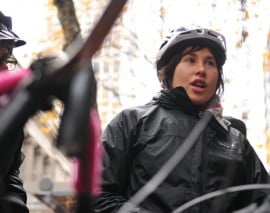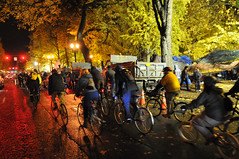
(Photo: Beth Nakamura/The Oregonian)
The ‘bike swarm’, like the Occupy movement itself, isn’t going anywhere. In fact, it’s getting stronger and smarter.
“With bikes you have so much mobility, it really changes the game, it opens up this whole new realm of possibilities of what you can do.”
— Katherine Ball
What began on the morning of November 13th as a way to lend support to Occupy campers facing eviction by the Portland Police Bureau, has evolved into an ongoing movement of its own; complete with dedicated volunteers, a new website, and strategy meetings.
Some in the community have voiced concerns about bike swarms’ intentions to obstruct the police. Others say they’d rather not have bicycling politicized by being injected into the Occupy demonstrations. But those involved in the swarm say they are committed to non-violent, legal activities and they point to their recent actions as proof that their methods are peaceful, law-abiding, and most importantly, successful.
Just what is the bike swarm?
In a nutshell, it’s a group or groups of people riding bikes during marches and other demonstrations. The people on bikes support the protests, and because they’re not on foot, they have strategic advantages: Bikes are vehicles so they’re allowed on the street; people on bikes have greater sight lines (especially those on double-decker tall bikes); and bike riders can move more quickly than people on foot.

swarm evolve in Portland.
(Photo © J. Maus)
Katherine Ball, a 27 year old activist currently enrolled in a Masters program at Portland State University, has been one of the more active participants in the bike swarms. “With bikes you have so much mobility,” she says, “it really changes the game, it opens up this whole new realm of possibilities of what you can do.”
Reid Parham, a 26 year old software engineer and Portland resident, has also participated in several bike swarm actions. He describes the role of the swarm as “maintaining the presence [of the protestors], but not being antagonistic at all.” While he speaks to the important strategic role the bikes have played at recent demonstrations, Parham says that the morale boosting impact the swarm has at marches is “absolutely, unquestionably the best part of it.”
Beyond the morale support and technical advantages, the symbolism of the bicycle during these events shouldn’t be underestimated.
Portland-based religious historian Keith Watkins, who hadn’t participated in any of the Occupy demonstrations until being inspired by the swarm, wrote about it in a recent entry on his blog:
“This small group of Portlanders used the unique features of human powered, two-wheeled vehicles in a wonderfully creative manner.
By rolling along through streets jammed with people, they maintained the principle that these streets are there to provide places for traffic to flow.
By their personal vulnerability on their fragile machines, they accented the importance of using modest modes of demonstrating power.
They manifested a whimsical spirit that seemed able to soften both sides of the often-tense face-offs.
… On this one long night… a few cyclists earned the respect of the city in a way that increases my delight that I too am a cyclist in this wonderful place.”
The impetus for the swarm began on the eve of the eviction, as Occupy Portland supporters got together to dream up ways to deal with the threat of police action. Once the riot police showed up and the standoff began, the bike swarm did laps around Chapman and Lownsdale parks for many hours. Occupy Portland campers and other supporters gave high-fives and shouted “Thank you cyclists!” as the pack rode by.
The climax of the swarm that morning was when the last line of riot-gear laden police relented their blockage of SW Madison Street and let a pack of swarmers roll through (that moment was caught on video by Dan Kaufman).
Ball was one of the leaders that night. She says there was so much positive energy among bike swarm participants that “there was an obvious sense that we should do it again.”
Ball collected names and emails and another activist, Dan Kaufman, started an email list (with the subject line of “Bike Check” — a play on the people’s microphone call of “Mic check”) and began spreading word of the swarm among other people in the bike scene.
That enthusiasm carried over into the bike swarm’s second big day of action — supporting the N17 demonstrations.
Ball and others reported that the bike swarm numbered about 100 people at the start of the N17 march. Despite claims that the police had hacked into their text messages and tried to confuse swarmers, Ball says N17 was another big success.
“It was much different than at the eviction, we broke up into four different groups. One was to create diversions for the cops, another was to go up on the sidewalk and create a barrier between cops and the march, another group went in front of the march, and the last group stayed on the opposite side of the street.”
Ball was in the diversion group and recalls that they gave the police “something else to think about” besides Occupiers taking over downtown banks.
The legal grey area that bikes occupy came into play during the N17 protests.
At one point Ball recalled one of the bike groups was surrounded by riot cops near Pioneer Square. The bike riders were legally in the street and they weren’t doing anything illegal. Then they began to chant, “Where’s it legal to ride your bike? In the road!” That moment created what Ball refers to as an “interesting role reversal, when we are following the law and the police are obstructing the law [by standing in traffic].”
“I want to operate in that [legal] grey area,” Ball continued, “Because it’s the space of greatest possibility.”
When I asked Ball about how that tactic might be considered confrontational, she explained that her method is to be “really nice to the cops.” Instead of yelling, “This isn’t illegal!”, for instance, Ball would ask them calmly, “Is this illegal?” Her goal is to keep things “playful”. “We need to have more of a dialogue with them.”
One criticism leveled against the bike swarm concept is that it drags bicycling into the muck of controversial political movements. More controversy and political baggage is the last thing bicycling needs, or so goes the argument.
Ball feels that it’s not a bad thing to politicize bicycling.
“I think it’s a big problem in the U.S. that we’re so afraid of politicizing things. We need to get involved in shaping the world we want. Shying away from participating in democracy or in politics is obviously not the right thing to do right now.”

The N17 bike swarm gave Ball and others a chance to try out new ways of participating in our democracy. “It worked,” she recalls, “and we thought, this is really exciting.”
Another bike swarm volunteer proposed a strategy meeting the next day. Over 30 people showed up, many more than anyone expected.
At that meeting, the group re-affirmed their goals and took charge of bike swarm’s future. They discussed a proactive communications strategy, which included buying the PDXBikeSwarm.org domain name and starting a Twitter account; and they discussed how best to deal with the legal grey areas bikes often find themselves in during the demonstrations.
“We agreed that our image so far is celebratory, festive, light-hearted and supportive to the protest actions that we buzz around,” read notes from the meeting.
The bike swarm seems to share much of the spirit — if not the practical methods — of critical mass. In some ways, the bike swarm is kinder, gentler, and more thoughtful than critical mass. Sort of like critical mass 2.0. For many activists that participated in critical mass, there was an adrenaline that came with ‘taking over the streets’. That sense of excitement helped fuel much of America’s modern-day bike advocacy; but it never quite led to the revolution on our roads many of us still hope for.
The bike swarm, standing on the shoulders of critical mass and bolstered by the Occupy movement, has a chance to do that. And for Ball, our love of bicycling and what it represents is precisely what could make it happen.
“How do we make the revolution as exciting as the next iPod?” she wonders, “That’s one of the things bicycles bring to this movement.”
—

If you’d like to learn more about the bike swarm, or consider getting involved, come to a meeting this Friday at 7:00pm at the Lucky Lab Brewpub on SE 12th and Hawthorne 8:00 pm at 707 NE Broadway #203. Stay tuned to PDXBikeSwarm.org for more details.


